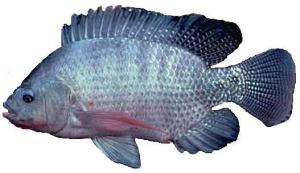Credits: Biovision-Infonet
The following are the important commercial aquaculture species cultured in Kenya:
Nile tilapia (Oreochromis niloticus)

(c) Mbugua Mwangi, Kenya
- Tilapia are indigenous to Africa, but have been introduced in many parts around the world.
- They are disease-resistant
- They are prolific breeders and reproduce easily under culture conditions
- Feed on a wide variety of foods and tolerate poor water quality with low dissolved oxygen levels.
- Can grow in brackish water and some will adapt to sea water
- Mainly grow under semi-intensive systems as monoculture, males only monoculture or polyculture with African catfish
- Optimum temperature range 27 – 30degC
- Very popular in Kenya and have a good market in world
- Fillets yield is from 30% to 37%, depending on fillet size and final trim
African catfish (Clarias gariepinus)

(c) Courtesy of Sagana Aquaculture Centre Kenya
- Indigenous to Africa.
- Can be described as omnivorous eating vegetable matter, zooplankton, insects, snails, tadpoles, leeches, small fish etc.
- Very hardy and can survive in low oxygen waters
- Can grow in brackish water in salinities of 10ppm
- Has ability to breath atmospheric oxygen
- Do not breed in captivity and artificial spawning is used
- Grows very quickly if adequate high protein feed is available.
- Few bones; has higher fillet percentage than tilapia
- Mainly grown in semi-intensive polyculture systems with tilapia
- Optimum temperature range 25 – 27degC
A good candidate for rural aquaculture in developing countries
Rainbow trout (Oncorhyncus mykiss)

(c) Mbugua Mwangi
- Native of North America but has been introduced and farmed all over the world
- A carnivorous fish which in natural waters consumes insects, crustacean and other small animals
- Grows well in cool fast flowing waters, 10 – 18degC, with high oxygen content
- Under culture conditions, require a water flow rate of 1 l/min/kg without aeration
- Trout will not spawn naturally in aquaculture systems and artificial spawning is used
- Produced in intensive systems in tanks and raceways
- Restricted to highland areas in tropical regions where favorable conditions allow
- Requires high quality feed, >40% protein.
- High market price, especially when fresh
- Fine bones; high fillet percentage and excellent when smoked.
Common carp (Cyprinus carpio)

(c) Courtesy of Sagana Aquaculture Centre Kenya
- An exotic species that has established itself in natural water bodies in Kenya
- An omnivore feeding onorganisms in mud at pond bottom, makes the pond water muddy.
- Eats a variety of supplementary foods including bran.
- Very limited aquaculture production in Kenya where they are grown under semi-intensive systems
- Attains a large size and does not usually overpopulate a pond.
- Optimum temperature range, 23 – 26degC
- Poor market in Kenya due to intramuscular bones but popular in Asia.